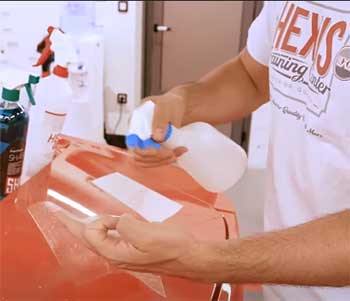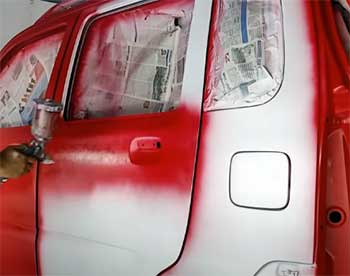When it comes to maintaining the look and feel of your car, two words often pop up – Paint Protection Film (PPF) and repaint. Each has its own unique benefits and drawbacks.
This article seeks to explore the depths of PPF and repaint, helping you to choose the perfect pick for your automobile. Buckle up as we delve into the world of auto care!
A Brief Comparison Table
| Factors | PPF | Repaint |
| Purpose | Protects the original paint job from minor physical damages | Recovers from extensive paint damage or transforms the vehicle’s look |
| Cost | Generally higher ($1,500 – $6,000 on average) | Varies based on paint quality and job complexity ($1,000 – $5,000 on average) |
| Longevity | 5 to 10 years with proper maintenance, but may show wear and tear over time | Several years with proper care, but doesn’t offer physical protection against scratches or chips |
| Maintenance | Requires less intensive maintenance due to self-healing properties | Requires regular maintenance like washing, waxing, and occasional minor touch-ups |
| Impact on Vehicle Appearance | Should be virtually invisible if applied professionally, enhances vehicle look | Can drastically change the vehicle’s appearance, can make an older model look new |
PPF: An Extra Layer of Defense

PPF, short for Paint Protection Film, is a thin polyurethane film or polymer that acts as an extra layer of shield on your car’s surface.
Its primary function?
Protecting your car’s paint job from potential damage like scratches, bird droppings, bug splatters, and even small rock chips.
The PPF offers a degree of self-healing features.
It means minor scratches on the film often disappear with time or exposure to heat, keeping your car always looking fresh.
This innovative technology is why many car owners consider the PPF a worthy investment.
But now you might ask, “Is PPF really worth it?” Well, the answer largely depends on your lifestyle and your car usage. If your car spends most of the time on busy roads or exposed to harsh elements, a PPF can extend the life of your paint job significantly.
However, PPF isn’t without its downsides. The major disadvantage of PPF coating for a car is its initial cost. Which brings us to the question, “What is the average cost of PPF coating?” While the price varies based on your location, type of car, and the surface area to be covered, you can expect to pay anywhere between $1,500 to $6,000.
So yes, it can be quite pricey.
Also, remember that PPF is a coating, and over time, it may start to show signs of wear and tear. But on the bright side, when maintained correctly, PPF can last anywhere from 5 to 10 years.
But does PPF change the look of paint? Good news here – if applied professionally, PPF should be virtually invisible, enhancing your car’s look rather than detracting from it.
Also Read: Differences Between Gtechniq Crystal Serum Ultra And Light.
Repaint: A Fresh Coat for Your Car
On the other side of the ring, we have repainting – the process of applying a new paint job to your vehicle. It can completely transform your car’s look, breathe new life into an older model, or help recover from extensive paint damage.
However, repainting is a lot more than slapping a new color onto your vehicle. It involves an elaborate process of surface preparation, primer application, sanding, and finally, several layers of color and clear coat.

This process ensures your car gets a glossy, durable finish that can withstand the rigors of the road.
Unlike PPF, repainting doesn’t offer the same level of physical protection against scratches or chips.
However, with proper care and maintenance, a high-quality paint job can last for several years and even add to your vehicle’s resale value.
The cost of repainting depends largely on the quality of the paint, the complexity of the paint job, and the pricing of the auto body shop.
On average, you might spend anywhere from $1,000 to $5,000, or even more for high-end jobs.
The Key Differences Between PPF And Repaint
Though PPF and repainting both involve your car’s aesthetics, they’re different in numerous ways. Here’s a breakdown of the key differences:
- Purpose
PPF is primarily a protective measure designed to guard the car’s original paint job against minor physical damage like scratches, chips, bird droppings, and bug splatters.
On the other hand, repainting is about refurbishing the vehicle’s look, often employed to recover from extensive paint damage or to give the car a brand-new look.
- Cost
In general, PPF tends to be pricier due to the advanced technology it employs and the specialized application it requires. On average, you could spend anywhere between $1,500 and $6,000.
Repainting costs can also vary widely, depending on the quality of the paint and the complexity of the paint job. Typically, a repaint job might cost between $1,000 and $5,000.
- Longevity
When maintained properly, a high-quality PPF can last anywhere from 5 to 10 years. However, over time it may show signs of wear and tear, requiring replacement.
A high-quality repaint job, if cared for appropriately, can also last for several years, but doesn’t offer the same level of physical protection against scratches or chips.
- Maintenance
PPF requires less intensive maintenance. Its self-healing properties ensure minor scratches often disappear with time or exposure to heat.
Repainting, however, demands regular maintenance like washing, waxing, and occasionally, minor touch-ups, to maintain its glossy and fresh appearance.
- Impact on Vehicle Appearance
While a professionally applied PPF should be virtually invisible, enhancing your car’s look rather than detracting from it, repainting can drastically change your car’s appearance. It can breathe new life into an older model or give it a completely new aesthetic.
These fundamental differences should give you a clear picture of what PPF and repainting can do for your vehicle. Your decision between the two will hinge on your personal needs, your car’s condition, and your budget.
Also Read: Differences Between Ceramic Pro And Xpel Fusion PPF.
Frequently Asked Questions (FAQ)
Yes, if your car spends a lot of time on busy roads or in harsh environments, PPF can protect and prolong the life of your paint job.
The major disadvantage of PPF coating is its initial cost, which can range from $1,500 to $6,000 depending on various factors.
The average cost of PPF coating can range from $1,500 to $6,000 based on the car’s type, location, and surface area to be covered.
When applied professionally, PPF should be virtually invisible and will not change the look of your car’s paint.
When applied professionally, PPF should be virtually invisible and will not change the look of your car’s paint.
The Final Verdict
Choosing between PPF and repaint largely depends on your unique needs. If preserving the original paint job and shielding it from physical damage is your priority, then PPF is the way to go.
However, if you’re dealing with significant paint damage, or simply want a new look for your car, then repainting would be the better option.
Always remember, neither of these options are ‘set and forget.’ Both demand regular maintenance to keep your vehicle looking its best.
Now that you’re equipped with knowledge about PPF and repaint, the power is in your hands. Choose wisely, and your car will continue to turn heads on the road for years to come!



